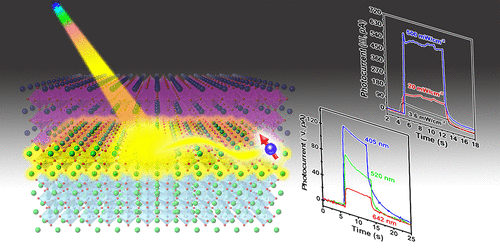当前位置:
X-MOL 学术
›
ACS Photonics
›
论文详情
Our official English website, www.x-mol.net, welcomes your
feedback! (Note: you will need to create a separate account there.)
Giant Photoresponse in Quantized SrRuO3 Monolayer at Oxide Interfaces
ACS Photonics ( IF 6.5 ) Pub Date : 2018-01-31 00:00:00 , DOI: 10.1021/acsphotonics.7b01339 Heng-Jui Liu,Jing-Ching Wang,Deok-Yong Cho,Kang-Ting Ho,Jheng-Cyuan Lin,Bo-Chao Huang,Yue-Wen Fang,Yuan-Min Zhu,Qian Zhan,Lin Xie,Xiao-Qing Pan,Ya-Ping Chiu,Chun-Gang Duan,Jr-Hau He,Ying-Hao Chu
ACS Photonics ( IF 6.5 ) Pub Date : 2018-01-31 00:00:00 , DOI: 10.1021/acsphotonics.7b01339 Heng-Jui Liu,Jing-Ching Wang,Deok-Yong Cho,Kang-Ting Ho,Jheng-Cyuan Lin,Bo-Chao Huang,Yue-Wen Fang,Yuan-Min Zhu,Qian Zhan,Lin Xie,Xiao-Qing Pan,Ya-Ping Chiu,Chun-Gang Duan,Jr-Hau He,Ying-Hao Chu

|
The photoelectric effect in semiconductors is the main mechanism for most modern optoelectronic devices, in which the adequate bandgap plays the key role for acquiring high photoresponse. Among numerous material categories applied in this field, the complex oxides exhibit great possibilities because they present a wide distribution of band gaps for absorbing light with any wavelength. Their physical properties and lattice structures are always strongly coupled and sensitive to light illumination. Moreover, the confinement of dimensionality of the complex oxides in the heterostructures can provide more diversities in designing and modulating the band structures. On the basis of this perspective, we have chosen itinerary ferromagnetic SrRuO3 as the model material, and fabricated it in one-unit-cell thickness in order to open a small band gap for effective utilization of visible light. By inserting this SrRuO3 monolayer at the interface of the well-developed two-dimensional electron gas system (LaAlO3/SrTiO3), the resistance of the monolayer can be further revealed. In addition, a giant enhancement (>300%) of photoresponse under illumination of visible light with power density of 500 mW/cm2 is also observed. Such can be ascribed to the further modulation of band structure of the SrRuO3 monolayer under the illumination, confirmed by cross-section scanning tunneling microscopy (XSTM). Therefore, this study demonstrates a simple route to design and explore the potential low dimensional oxide materials for future optoelectronic devices.
中文翻译:

氧化物界面上定量的SrRuO 3单层中的巨大光响应
半导体中的光电效应是大多数现代光电器件的主要机制,其中足够的带隙在获得高光响应方面起着关键作用。在该领域中使用的众多材料类别中,复合氧化物具有很大的可能性,因为它们呈现出很宽的带隙分布,用于吸收任何波长的光。它们的物理性质和晶格结构始终紧密耦合并且对光照敏感。此外,异质结构中复合氧化物尺寸的限制可以在设计和调制能带结构方面提供更多的多样性。基于此观点,我们选择了行程铁磁SrRuO 3作为模型材料,并以一个单元格的厚度制作它,以打开一个小的带隙以有效利用可见光。通过在发达的二维电子气系统(LaAlO 3 / SrTiO 3)的界面上插入该SrRuO 3单层,可以进一步揭示单层的电阻。此外,还观察到在功率密度为500 mW / cm 2的可见光照射下光响应的显着增强(> 300%)。这可以归因于对SrRuO 3的能带结构的进一步调制横截面扫描隧道显微镜(XSTM)确认在光照下形成单层。因此,这项研究表明了设计和探索用于未来光电器件的潜在低维氧化物材料的简单途径。
更新日期:2018-01-31
中文翻译:

氧化物界面上定量的SrRuO 3单层中的巨大光响应
半导体中的光电效应是大多数现代光电器件的主要机制,其中足够的带隙在获得高光响应方面起着关键作用。在该领域中使用的众多材料类别中,复合氧化物具有很大的可能性,因为它们呈现出很宽的带隙分布,用于吸收任何波长的光。它们的物理性质和晶格结构始终紧密耦合并且对光照敏感。此外,异质结构中复合氧化物尺寸的限制可以在设计和调制能带结构方面提供更多的多样性。基于此观点,我们选择了行程铁磁SrRuO 3作为模型材料,并以一个单元格的厚度制作它,以打开一个小的带隙以有效利用可见光。通过在发达的二维电子气系统(LaAlO 3 / SrTiO 3)的界面上插入该SrRuO 3单层,可以进一步揭示单层的电阻。此外,还观察到在功率密度为500 mW / cm 2的可见光照射下光响应的显着增强(> 300%)。这可以归因于对SrRuO 3的能带结构的进一步调制横截面扫描隧道显微镜(XSTM)确认在光照下形成单层。因此,这项研究表明了设计和探索用于未来光电器件的潜在低维氧化物材料的简单途径。










































 京公网安备 11010802027423号
京公网安备 11010802027423号